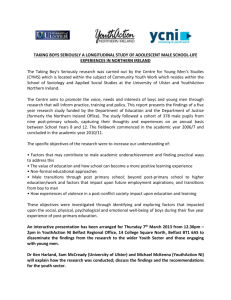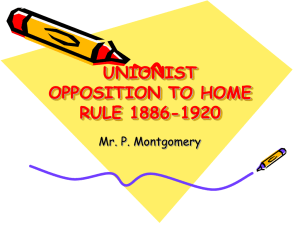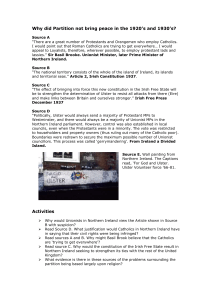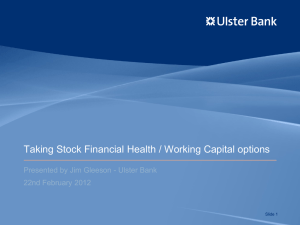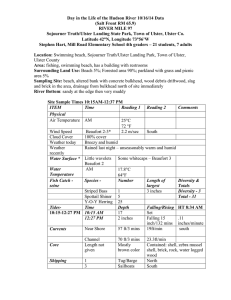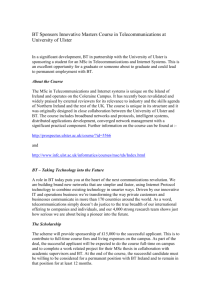Speech by Nelson McCausland MLA, Minister for Culture Arts and... Thursday 20 June 2010
advertisement
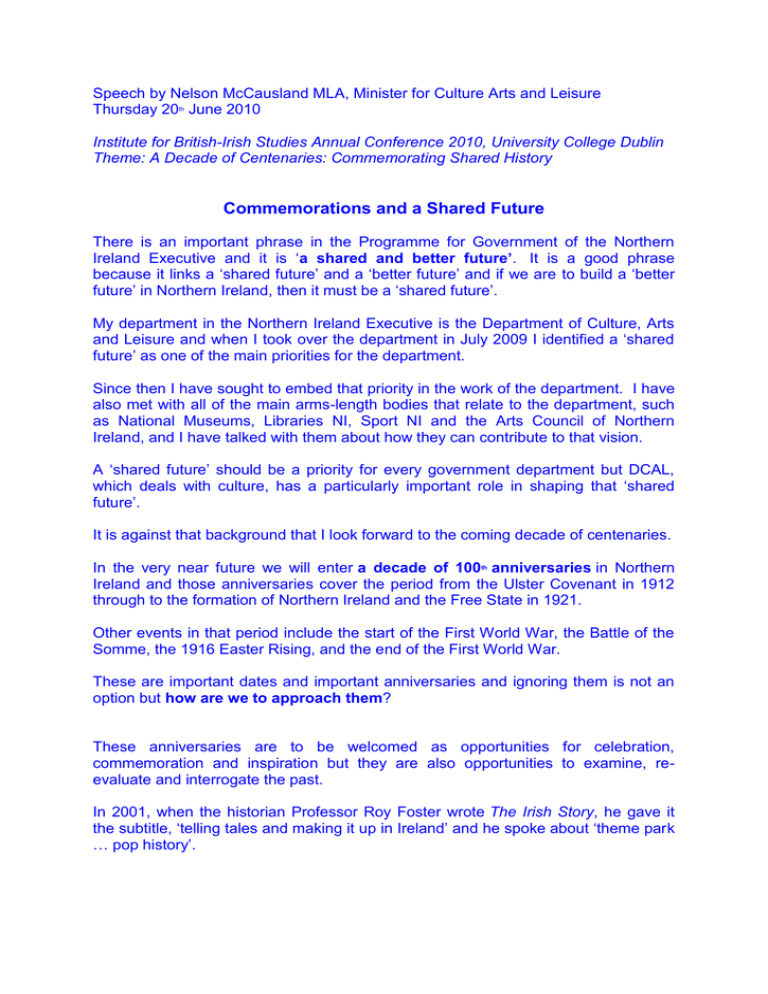
Speech by Nelson McCausland MLA, Minister for Culture Arts and Leisure Thursday 20th June 2010 Institute for British-Irish Studies Annual Conference 2010, University College Dublin Theme: A Decade of Centenaries: Commemorating Shared History Commemorations and a Shared Future There is an important phrase in the Programme for Government of the Northern Ireland Executive and it is ‘a shared and better future’. It is a good phrase because it links a ‘shared future’ and a ‘better future’ and if we are to build a ‘better future’ in Northern Ireland, then it must be a ‘shared future’. My department in the Northern Ireland Executive is the Department of Culture, Arts and Leisure and when I took over the department in July 2009 I identified a ‘shared future’ as one of the main priorities for the department. Since then I have sought to embed that priority in the work of the department. I have also met with all of the main arms-length bodies that relate to the department, such as National Museums, Libraries NI, Sport NI and the Arts Council of Northern Ireland, and I have talked with them about how they can contribute to that vision. A ‘shared future’ should be a priority for every government department but DCAL, which deals with culture, has a particularly important role in shaping that ‘shared future’. It is against that background that I look forward to the coming decade of centenaries. In the very near future we will enter a decade of 100th anniversaries in Northern Ireland and those anniversaries cover the period from the Ulster Covenant in 1912 through to the formation of Northern Ireland and the Free State in 1921. Other events in that period include the start of the First World War, the Battle of the Somme, the 1916 Easter Rising, and the end of the First World War. These are important dates and important anniversaries and ignoring them is not an option but how are we to approach them? These anniversaries are to be welcomed as opportunities for celebration, commemoration and inspiration but they are also opportunities to examine, reevaluate and interrogate the past. In 2001, when the historian Professor Roy Foster wrote The Irish Story, he gave it the subtitle, ‘telling tales and making it up in Ireland’ and he spoke about ‘theme park … pop history’. There are so many myths, so many misunderstandings and so many misrepresentations about the history of Ulster and of Ireland and these anniversaries afford us an opportunity to consider them and confront them. How then are we to approach tem? I believe that we can learn some important lessons from past commemorations such as the centenary and the bicentenary of the 1798 rebellion. In 1891 the centenary of the founding of the United Irishmen was hijacked by Irish nationalists and republicans who sought to portray themselves as the natural successors of the United Irishmen. However there was an interesting situation in Belfast where republicans organised a celebration and visited the grave of Dr William Drennan. This led Drennan’s son, Dr John Swanwick Drennan, to write to the press protesting strongly ‘against any attempt to identify his (father’s) name and opinions with those of the present socalled Nationalists and Nationalism’. Again in 1898, the centenary of the rebellion, Irish nationalists and republicans hijacked the commemoration with what Foster called ‘a lot of dressing up and posing with pikes’. Meanwhile in Belfast they organised a Dr Drennan Centenary Club and this time Drennan’s grand-daughter, Mrs Maria Duffin, wrote in a similar vein stating that ‘Dr Drennan was at first opposed to the Union but afterwards modified his view of it’. The bicentenary of the rebellion in 1998 should have afforded an opportunity for a more reflective assessment of the United Irishmen. The fact is that most of the United Irishmen in Ulster were eventually reconciled to the Union and by December 1811 William Drennan was advising the readers of the Belfast Monthly Magazine, the literary journal he had launched in 1808, to ‘Be Britons with all your souls – and forget your father called himself an Irishman.’ Such are the complexities and apparent contradictions of our history and they deserved to be explored but unfortunately the opportunity that was there in 1998 was squandered. The Ulster Museum produced an exhibition but outside of that most of the other commemorations were dominated by nationalists with only a token unionist presence. It is also worth noting the 50th anniversary of the 1916 Rebellion, which had a destabilising effect in Northern Ireland. In Belfast the main commemoration was a republican parade by 20,000 people to Casement Park. This included 400 members of the GAA, as well as members of camogie clubs, Irish dancers and the executive of the Belfast Trades Council. The chairman of the organising committee was Leo Martin, a veteran Belfast republican who became OC of the Northern Command of the Provisional IRA, and the main speaker was Seamus Costello. However there are also examples of good practice and in 1990 much of the exploration around the tercentenary of the Boyne was highly successful in challenging the insularity of some perspectives and recognising the broader European context of the Glorious Revolution and the Battle of the Boyne. In that regard the Ulster Museum exhibition Kings in Conflict was excellent. We cannot afford to squander the opportunities that are now coming forward. The centenary of the Ulster Covenant affords an opportunity to look back to the events surrounding the Covenant and that includes the signing of the Covenant in the border counties of Cavan, Monaghan and Donegal. The story of the Unionist communities in those counties is part of the Covenant story. This centenary is also an opportunity for the second political nation to explain itself. The Ulster Covenant was inspired by the old Scottish covenants and it is said to have been written by Thomas Sinclair, the leading Liberal Unionist of his day and the leading layman in the Presbyterian Church. It was and is a profound expression of Ulster Unionist thought and it is as relevant today as it was then because it has in it the core principles of Unionism. 1. 2. 3. 4. 5. It speaks of ‘civil and religious freedom’ or as we might say today ‘human rights’ and of course those rights are not just for one section of society but for everyone. It speaks of ‘citizenship’ and there was at that time a strong awareness of the meaning of citizenship and also the rights and responsibilities of citizenship. It speaks of Ulster and the ‘men of Ulster’ and their place within the United Kingdom. It speaks of the ‘material well-being’ of Ulster within the United Kingdom. It speaks of ‘equal citizenship’ within the United Kingdom. The centenary will therefore provide unionists with an opportunity to reflect on the meaning of the union and unionism and to set out a broad unionist agenda, a unionist vision for the future, as we move to the end of the first century of Northern Ireland and then beyond that into the next. There are also important opportunities for Irish nationalists. For example, the centenary of 1916 offers those of an Irish nationalist background an opportunity to reflect on republican ideology and the results of that ideology. It also affords Irish nationalists an opportunity to broaden their story. The year 1916 should be remembered as much for what happened on the battlefields of France as what happened on the streets of Dublin. Those Irishmen who fought in France must not be forgotten. Another aspect of that period that deserves exploration is the difference between Belfast and Dublin. Within nationalism in Belfast there has always been the constitutional nationalist strain as well as the recidivist republican strain but for most of the time it has been constitutional nationalism that has been to the fore. In Belfast most of the Irish volunteers remained loyal to Redmond and this was the city that chose Joe Devlin before de Valera. Today Sinn Fein is to the fore within nationalism but that is not the way it always was. However I must also sound a warning note as regards the legacy of 1916. There is the real danger of a veneration that could encourage and assist those dissident republicans in Northern Ireland who want to indoctrinate another generation of young men to pursue the nihilistic path of violence. Of course we are already in the midst of a decade of 400th anniversaries as well and the 100th anniversaries must not be allowed to overshadow or marginalise the 400th anniversaries because the events a the start of the 17th century are just as important as those at the start of the 20th century. Back in the year 1606, before the Flight of the Earls in 1607 and before the Plantation of Ulster, thousands of Scottish settlers started to arrive in east Ulster as part of the settlement organised by Sir James Hamilton and Sir Hugh Montgomery. They were the ‘founding fathers’ of the Ulster-Scots and from them came a people who helped to shape modern Ulster. Unfortunately in 2006, the 400th anniversary, this seminal event, which created a bridgehead for further Scottish settlement, was almost forgotten and ignored. It was only through the efforts of the chairman of the Ulster-Scots Agency, Mark Thompson, and a small group of Ulster-Scots activists that it was marked at all, and in the end, albeit rather belatedly, the BBC produced a documentary film. So many accounts of the Plantation are superficial, simplistic or just simply wrong. This is reflected in and illustrated by some of the letters that appear from time to time in the pages of our newspapers. Some nationalists and republicans still try to turn the Plantation into propaganda and that may well be why the Hamilton and Montgomery story has been marginalised. It doesn’t fit into the story of ‘stolen land’ that has been created by the propagandists. Neither does the fact that the Earl of Antrim, the largest Roman Catholic landowner in Ulster, brought over hundreds of Protestant settlers or tenants on to his estate, or the fact that King James I expelled many of the reivers from the Scottish Borders and moved them across to Ulster. Is there not an opportunity to interrogate the Plantation myths that have been used in the past by extremists to recruit young people to their cause. Yes there is and it must not be squandered. Is there not an opportunity to recover some of the ‘lost stories’ of our history? Yes there is and it must not be squandered. I am determined to do all that I can to ensure that we use the opportunities that these commemorations will bring to create a better understanding and appreciation of our history and to that end I have already convened a meeting of all the relevant armslength bodies. I spoke to them in the context of a ‘shared future’ and said that I wanted to see how we could develop a coherent and comprehensive strategy for commemoration, one that would bring maximum value through collaboration and cooperation. This initiative received a very positive response and work is well underway on that strategy. The first event will be the centenary of the Ulster Covenant and so I use that as an example. Clearly there is a role for major institutions such as National Museums and the Public Record Office, especially as the latter holds the archive of the Ulster Unionist Council, including the Ulster Covenant, and I will want to see a major exhibition on the Ulster Covenant in 2012. The creation of a new Ulster-Scots Broadcast Fund, which will support cultural and historical programmes, as well as language-based programmes, is also relevant, as a source of funding for television programmes or films on the Covenant. We are also moving forward with the establishment of the Ulster-Scots Academy and it will be able to facilitate serious academic research on this and other aspects of our history. These are just some of the ways in which we can support the commemoration of the Covenant and of course, as the first anniversary in the series of centenaries, it will set the tone for the rest. Commemorations can help or hinder a shared future. We must seek to ensure that they help rather than hinder and I hope that will be the case in Northern Ireland and here in the Irish Republic. Everyone will have to step up to the mark, government, media, education, academia and society at large but if we really believe in the vision of a ‘shared future’ and if we do step up to the mark, then at the end of the decade of centenaries we will be much further along the road towards that vision.
